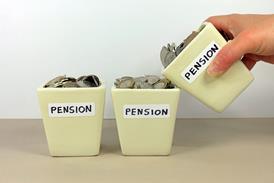The Combined Nuclear Pension Plan has added a commercial ground rents fund to its portfolio as part of its interest in assets with long-term inflation-linked cash flows.
Property has long been a popular asset class for pension funds looking for sources of income in a low-yield environment. As events such as Brexit and the US election continue to shake up financial markets, real estate has been a safe place for schemes looking to manage risk.
The last few years have seen a significant increase in popularity for ground lease strategies leading to strong absolute returns
Ajeet Manjrekar, P-Solve
Last year, the defined benefit section of the £2.04bn Combined Nuclear scheme commenced investment in a ground rent property fund managed by Standard Life.
The scheme has an allocation of around 10 per cent of its portfolio to real estate and about 0.6 per cent to the ground rents fund.
The scheme said that this fund was chosen to provide capital growth and income through investment in UK commercial ground rents from across a number of property sectors.
Property and positive returns
Steve Hayton, scheme secretary, said the trustees have worked to increase their allocation to property over the past five years.
He said: “The attraction of investing in property has typically been the rental income stream generated, which has underpinned positive returns over a number of decades”.
In addition to core commercial UK property, the scheme invests in commercial ground rents and other long lease properties. This is in order to “capture a secure income stream… generated from rents paid by high-quality tenants to occupy a fundamentally attractive property over a long-time horizon”, said Hayton.
He explained that “these types of property investments are attractive for the CNPP Trustee, who is looking to invest in long-term inflation-linked cash flows… without the need to be overly concerned about the illiquidity associated with the investment”.
Increased popularity
Mat Thomas, investment partner at consultancy LCP, said that investing in ground rents can be “incredibly secure” and “tends to be very long-dated income”.
The expected returns can be quite low, he said, but “it does make sense as an alternative way to match some cash flows”.
Thomas also noted that the attractiveness of ground rent funds “has probably picked up quite substantially, given that the yields on everything else have become quite low”.
Source: Mercer European Asset Allocation Survey 2015
Ajeet Manjrekar, co-head of P-Solve, said that “the last few years have seen a significant increase in popularity for ground lease strategies leading to strong absolute returns”.
He added: “However, several of the leading funds have queues to allocate new monies given the limited availability of new ground lease assets. In turn, this is leading to a compression in the income yield available for new investors.”
Peter Hobbs, managing director of private markets at bfinance, noted that pension funds’ appetite for property increased following the global financial crisis.
As the market started to reach a cyclical peak at the end of 2015 and early 2016, “appetite reduced, and this has continued following the Brexit decision”, said Hobbs.
But he added that as equity markets rallied, pushing up the proportion of equities in scheme portfolios, many pension funds are now slightly behind their target allocations for property and are therefore seeking to increase their property exposure.
Withstanding market shocks
However, Hobbs noted that schemes are also being cautious given the uncertain outlook since the Brexit decision.
“Right now, given that the market has experienced seven strong years of performance and is at the late stage of the cycle, many pension funds are considering how best to ‘hunker down’, or positioning their portfolios to withstand any market downturn,” he said.
What role can property play in a pension fund portfolio?
UK pension funds face a number of challenges: mature funds need to find sources of income in a low-yield environment, and younger funds in their growth phase are looking for high-growth assets at a time when the economy is growing only sluggishly.
Strategies that can help with this include real estate debt or high income and long lease, according to Hobbs.
Investors can also turn to international property, taking away some of the UK exposure, or opt for value-added rather than core property, which he said would be “negatively impacted by rising interest rates”.
Smaller schemes can access property through multi-managers, funds of funds, large open-ended funds or real estate investment trusts. Hobbs said although many see REITs as equity rather than property, they “tend to perform in a similar way to direct property over the medium [to] long term”.














